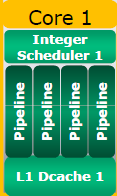The Bulldozer Aftermath: Delving Even Deeper
by Johan De Gelas on May 30, 2012 1:15 AM ESTInteger Crunching Power
Each core has two integer executions units (EX0 and EX1) and two AGUs (Address Generation Units). For comparison, the K10 core inside Magny-Cours and Istanbul had three ports to a “Fully featured ALU + AGU” couple. AMD marketing cleverly drew four pipeline blocks inside the Bulldozer integer core, but those powerpoint blocks cannot hide the fact that each Bulldozer integer core has fewer execution resources.

In practice, the AG0 and AG1 are little more than assistants with limited capabilities to EX0 and EX1.The software optimization guide for AMD family 15h processors lists only a few instructions (page 248 in the January 2012 version) that can be processed by the AG0 and AG1 execution units and each time the remark "First op to AG0 | AG1, Second to EX0 | EX1" is made. The AG0 and AG1 execution units reduce the latency of the CALL and LEA instructions, but the maximum throughput of each integer core inside the Bulldozer module is only two integer instructions per clock cycle. It's only when a fused branch enters EX0 and another integer instruction can enter EX1 that we have a slightly higher throughput of three integer instructions.
So the Bulldozer integer core can execute one integer instruction less per cycle (2 vs 3). That doesn’t mean that the Bulldozer integer core is 1/3 slower, however. The integer core of Bulldozer is smaller but also more flexible. The per lane dedicated 8-entry schedulers are gone, and a much larger 40 entry scheduler replaced it. This means that Bulldozer should be better at extracting ILP (Instruction Level Parallelism) out of code that has low IPC (Instructions Per Clock).
In some integer intensive applications, the fact that the maximum throughput of integer instructions is somewhat lower might slow things down. That is the not very useful "it depends" answer, so let's clarify: what kind of applications are we talking about?










84 Comments
View All Comments
ArteTetra - Wednesday, May 30, 2012 - link
"A core this complex in my opinion has not been optimized to its fullest potential. Expect better performance when AMD introduces later steppings of this core with regard to power consumption and higher clock frequencies."You don't say?
JohanAnandtech - Thursday, May 31, 2012 - link
A quote by a reader, not ours :-). The idea is probably that Bulldozer was AMD's very first implementation of their new architecture.haplo602 - Wednesday, May 30, 2012 - link
now this was a great read. finaly something interesting (the consumer benchmarks are NOT intereseted anymore for me).I hope there will be a differential analysis once you have Piledriver CPUs available.
JohanAnandtech - Thursday, May 31, 2012 - link
Piledriver analysis: definitely. Thanks for the encouraging words :-)mikato - Friday, June 1, 2012 - link
I agree - great critical thinking in this article! This subject definitely needed more research.Spunjji - Wednesday, June 6, 2012 - link
+1. This is the sort of thing I come here for!Beenthere - Wednesday, May 30, 2012 - link
Expecting Vishera to be an Intel killer is foolish as it's not going to happen and there is no need for it to happen. Ivy Bridge is very much like FX in that it's only 5% faster than SB and runs hot. At least FX chips OC and scale well unlike Ivy Bridge.If AMD can use some of the techniques imployed in Trinity they should be able to get a 15+% improvement over the FX CPUs. This combined with higher clockspeeds now that GloFo has sorted 32nm production should provide a nice performance bump in Vishera.
95% of consumers do not buy the fastest, most over-hyped and over-priced CPU on the planet for their PC or server apps. Mainstream use is what AMD is shooting for at the moment and doing pretty well at it. Eventually they will release APUs for all PC market segments that perform well, use less power and cost less than discrete CPU/GPU combo. THAT is what 95% of the X86 world will be using.
Homeles - Wednesday, May 30, 2012 - link
"Ivy Bridge is very much like FX in that it's only 5% faster than SB and runs hot"I think you need to go read about Intel's tick-tock strategy.
Also, unlike Bulldozer, Ivy Bridge was a step forward. A small one, but performance per watt went up, while with Bulldozer it often went backwards.
Process maturity from GloFo will help, but probably not as much as you would think.
Finally, "95% of users" aren't going to benefit best from a processor built with server workloads in mind. Even with server workloads, Bulldozer fails to deliver. APUs are definitely the future, but keep in mind that Intel's had an APU out for as long as AMD has. If you think that AMD's somehow going to pull a fast one on Intel, you're delusional. Intel and Nvidia as well are very, very well aware of heterogeneous computing.
The_Countess - Wednesday, May 30, 2012 - link
looking at how much the performance per watt went up with piledriver compared with llano, I think they''ll have a lot more headroom on the desktop and server space to increase the clock frequencies to where they are suppose to be with the bulldozer launch.Homeles - Wednesday, May 30, 2012 - link
Yeah, Piledriver will likely perform the way AMD had intended Bulldozer to perform.